Fire safety guidance for care homes
The guidance aims to assist those who have responsibility under the Fire (Scotland) Act 2005 for ensuring fire safety in care homes in Scotland.
CHAPTER 7: PROVISION AND USE OF MEANS OF ESCAPE
194. Means of escape is the provision of safe escape routes for people to travel from any point in a building to an unenclosed safe area beyond the premises, and includes the measures to maintain those routes. Once a fire has been detected and a warning given, everyone in a care home should, if necessary, be able to move or be assisted away from the fire to a place of reasonable safety such as an enclosed protected stair or another compartment or sub-compartment from where they should be able to continue to escape to an unenclosed safe area beyond the premises.
195. Means of escape should be provided both in terms of the number and capacity of escape routes and in terms of their protection from fire and smoke. When determining whether premises have adequate escape routes, a number of interdependent factors should be considered, including:
- The dependency, number and location of people in the premises;
- The method of moving high dependency residents;
- The construction of the premises and the potential for fire and smoke spread;
- The fire compartmentation of the premises; and
- The time it will take people to escape.
ESCAPE ROUTES
196. Care homes will normally have at least two independent escape routes from each storey of the premises used by residents.
197. Each sub-compartment should have at least two exits which give access to open air, a protected stair or an adjoining compartment or sub-compartment. Where a compartment or sub-compartment does not have either a final exit or direct access to a protected stair, each adjoining compartment or sub-compartment should then have a final exit or direct access to a protected stair. Figure 5 shows an upper floor arrangement with three sub-compartments served by two escape stairs.
Figure 5 - Upper Floor Arrangement
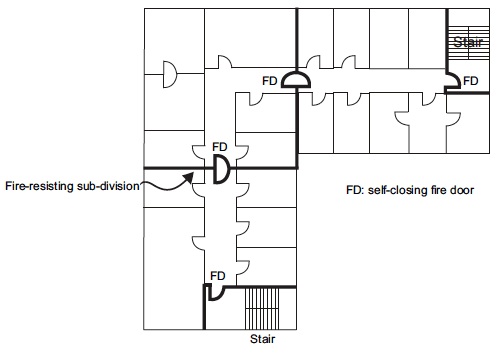
198. A room with an occupant capacity of more than 60 should have at least two exits, the directions of travel from any point within the room should:
- Diverge at an angle of at least 45o; or
- Be combined for a distance of not more than 9m and then diverge at an angle of at least 45 o plus 2½ o for every metre travelled in one direction.
199. The sequence of travel for an escape route is to access a safe area beyond the building (or to another compartment):
- Directly;
- By way of a corridor or a protected stair;
- By way of a corridor to a protected stair;
- By way of a flat roof (for persons who can safely make use of such a route);
- By way of an exit to an external escape stair (for persons who can safely make use of such a route); or
- In the case of an inner room not used as sleeping accommodation, by way of one other room (but not through boiler or plant rooms etc).
200. Windows are not suitable as means of escape in a care home.
201. An escape route should not be by way of a lift. Lifts should not be used for evacuation unless specifically designed for the purpose.
202. A clear headroom for escape routes and circulation areas is at least 2m, and not less than 1.9m in a doorway.
203. The width and geometry of escape routes should be sufficient to facilitate the evacuation method used for residents. An unobstructed width at least 1200mm may be necessary for high dependency residents but where the residents are low dependency, not less than 1000mm may be adequate. At doorways the width can normally be reduced by 150mm.
204. Where the evacuation strategy is progressive evacuation, compartments and sub-compartments should have sufficient space to accommodate the additional persons who may be evacuated into these areas temporarily.
205. Where possible and appropriate, a door across an escape route should open in the direction of escape to assist with evacuation, particularly where the occupancy capacity is 60 or more, or where occupants may need to exit quickly or the door is a final exit.
206. The area outside final exit doors should have suitable hard standing underfoot for persons being evacuated and provided with pathways so that residents can move, or be moved, to a place of safe congregation away from the building.
TRAVEL DISTANCE
207. There should be a limit on the distance that persons should have to travel to reach a place of reasonable safety. Travel distance is the distance measured along the actual route of escape (having regard to the layout of furniture and fittings) from any point within a storey to the nearest door giving direct access to either another sub-compartment; another compartment; a protected stair; or to a final exit. An assessment of travel distance should be made by reference to Table 6.
Table 6 - Travel Distance by Reference to Residents and Suppression
| Dependency of resident |
Suppression system |
Single direction distance (m) |
Maximum distance* (m) |
|---|---|---|---|
| High |
No |
9 |
18 |
| Yes |
12 |
25 |
|
| Medium |
No |
12 |
25 |
| Yes |
15 |
32 |
|
| Low |
15 |
32 |
* This includes the single direction distance.
208. A single direction of escape is travel before there is the choice of escape routes. Single direction ceases at the point where there are alternative routes. See Figures 6, 7 and 8. A single direction of escape may involve persons moving towards or past a fire, if the fire occurs between the occupant and the choice of escape routes.
Figure 6 - Single Direction of Escape Within a Room Before a Choice of Escape Routes Become Available
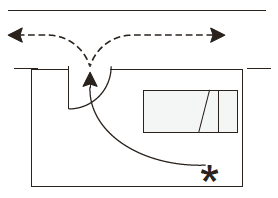
Figure 7 - Single Direction of Escape Out of Room and Along a Corridor Before a Choice of Escape Routes Become Available
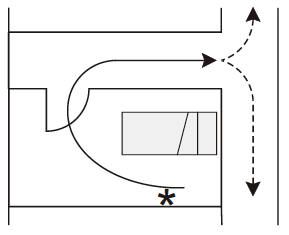
Figure 8 - Single Direction of Escape Within a Room Before a Choice of Escape Routes, One of which Goes Through a Fire Door into Another Compartment or Sub-Compartment
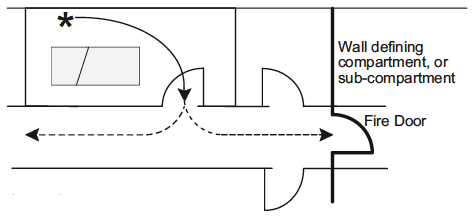
INNER ROOMS
209. An inner room is a room where access to a circulation area can only be achieved by passing through an access room (see Figure 9). A fire could develop unnoticed in the access room preventing the occupant of the inner room escaping. The following conditions will limit the risk to persons in the inner room:
- inner room not used as a bedroom;
- access room contains limited combustibles and ignition sources; and
- travel distance from any point in the inner room to the exit from the outer room no greater than 9m, unless there are alternative exits from the outer room.
Figure 9 - Inner Room Arrangement
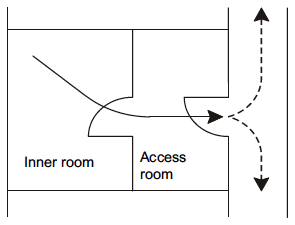
STAIRS
Escape stairs
210. To protect escape routes from fire, the normal standard for escape stairs is for stairs to be enclosed within a fire-resisting enclosure (creating a protected zone) such that the enclosing structure between the stair and the rest of the building has at least 60 minutes fire-resistance and any door in the enclosing structure at least an FD 60S self-closing fire door. This arrangement is shown in Figure 10. Each escape stairs should have its own independent final exit.
Figure 10 - Protection of Escape Stairs

211. If an external wall of the building makes an angle of not more than 135o with the external wall of the enclosure, the wall or enclosure should have at least 30 minutes fire-resistance for a distance of 2m.
212. Where the effective width of an existing escape stair is less than 1200mm, a check should be made that the width of the stair is suitable for the persons who would use it and the method of evacuation.
213. Where part of a building has only one escape route by way of an escape stair, for example a stair serving part of the building not used by residents, if access to the escape stair is by way of a protected lobby, this will provide an additional barrier to fire and may afford people additional time to escape. A protected lobby is where there are two self-closing fire doors between the adjoining accommodation and the stair. Thirty minutes fire-resistance (for integrity only), and any door in the wall at least an FD 30S self‑closing fire door.
214. Where an escape stair also serves a basement storey, a self-closing fire door at ground-floor level separating the basement stair enclosure from the stair enclosure serving the rest of the building, will provide improved protection to the means of escape from any fire that may start in the basement.
215. Ideally, an escape stair (including landings) and the floor of a protected lobby will be non-combustible. Where an existing escape stair is combustible, consider the potential for the stair to be directly affected by fire, such as a fire occurring in an under-stair cupboard, and the possibility of lining the underside of the stair with non-combustible material.
216. A cleaner's cupboard not more than 3m2, a toilet or a washroom may be sited within the protected zone enclosing an escape stair if:
- the fire risk is considered low;
- no flammable materials are stored in the rooms; and
- all other parts of the building served by the escape stair have at least one other escape route.
217. The walls, floors and ceiling separating a cleaner's cupboard from the protected zone should have 30 minutes fire-resistance. A door to a cleaner's cupboard should be at least an FD 30S fire door but need not be self‑closing provided it is kept locked.
External stairs
218. An external escape stair may present problems for persons evacuating a building because people can feel less confident using an unenclosed stair at a height. For this reason, an external escape stair may only be suitable where the topmost storey height is not more than 7.5m; and the stair is used only by those who can safely make use of it. Appropriate weather protection may be necessary to enable the stair to be used in all weather conditions.
219. An external escape stair should lead directly to a safe area beyond the premises and should be non-combustible.
220. An external escape stair may be unusable if fire occurs in the building. External stairs with a rise more than 1.6m, may need to be protected against fire from within the building with at least 30 minutes fire‑resistance.
ESCAPE ACROSS FLAT ROOFS
221. An escape route across a flat roof should be used only for those who can safely make use of it, and be an alternative additional provision to a protected stair in a building.
222. The following criteria apply to an escape route across a flat roof:
- be clearly defined, illuminated and guarded with protective barriers not less than 1.1m in height;
- have a slip-free surface;
- have at least 60 minutes fire-resistance for a distance of 3m on either side of the route;
- have no unprotected openings such as roof ventilators, windows or other openings, from adjacent rooftop structures, within a distance of 2m; and
- any wall within 3m of the route, having at least 30 minutes fire-resistance up to a height of at least 1.1m from the level of the escape route.
DOOR FASTENING
223. It is important that doors can be easily opened. Where a door across an escape route has to be secured against entry, it should be fitted with a fastening which is readily operated without a key, from the side approached by people making their escape. Where a door is operated by a code, combination, card, biometric data or similar means, it should be capable of being manually overridden from the side approached by people making their escape. Where there is a need to protect people who may be unable to keep themselves safe if they wander off, and some form of control is necessary under non-fire conditions, door-release systems can be provided which allow manual opening only under fire conditions or are fitted with door alert systems or break domes.
224. Push pad devices (to BS EN 179) are suitable securing devices for outward opening final exit doors where occupants can be expected to be familiar with the devices. In other cases, panic exit devices operated by a horizontal bar (to BS EN 1125), are suitable.
225. A door with a fastening which can only be opened from one side of the door may offer difficulty for staff during an evacuation. Members of staff after passing through the door in an emergency situation, could be prevented from re-entering the building by this route to assist residents if the door closes behind them, especially if the door is self‑closing.
226. Control measures may be required to safeguard residents who are prone to wandering and who may be at risk of injury if they pass through doors unsupervised. There are a number of options for egress control, some are listed below:
- electrically powered lock (with appropriate fail-safe);
- thumb-turn latch;
- confusion lock;
- increased staff supervision;
- motion detector which actuates local alarm;
- door exiting alert; or
- relocation of particular residents.
Electrically powered locks
227. Electrically powered locks can be operated by electromagnetic or electromechanical means. Electromagnetic are considered to be more reliable than electromechanical due to the absence of moving parts and their inherent 'fail-safe' operation.
228. Electrically powered locks should not be installed on any door which provides the only route of escape from the building or part of the building.
229. Electrically powered locks should return to the unlocked position:
- On operation of the fire warning system;
- On loss of power or system fault; and
- On actuation of a manual door release unit positioned at the door on the side approached by people making their escape (where the door provides escape in either direction, a unit should be installed on both sides).
230. BS 7273: Part 4 provides detailed guidance on the electrical control arrangements for the fail-safe release of powered locks.
Locking of bedroom doors
231. Where management allow residents to lock their bedroom doors, the following should apply:
- a suitable lock will be one that can be easily overcome by force in an emergency;
- such doors should be readily openable from the inside without the use of a key;
- members of staff should carry a master key for the doors; and
- management should ensure that a robust staff master key handover is established.
Automatic opening doors
232. An internal door may be linked to a motion sensor or other device so that the door opens automatically to facilitate movement of residents. Some devices can be triggered by smoke movement which may cause a door to open precisely at the time when it should be closed as a barrier to fire and smoke. These doors should be linked to the fire warning system so that the automatic opening function is disabled if the fire warning system is triggered (but still permitting the door to be manually opened). If the door is a fire door, the opening mechanism should not reduce the fire resistance of the door. When the automatic opening function is disabled following actuation of the fire warning system, the fire door's normal self-closing function should continue to operate.
233. Automatic opening doors should not be placed across exits unless they are designed in accordance with BS 7036 and are either:
- arranged to fail safely to outward opening from any position of opening; or
- are provided with a monitored fail-safe system for opening the door from any position in the event of mains supply failure and also in the event of failure of the opening sensing device; and opens automatically from any position in the event of operation of the fire alarm in the fire alarm zone within which the door is situated.
Powered sliding doors
234. Powered sliding doors often open in response to a motion sensor. Such a door across an escape route, should fail-safe and should open:
- On operation of the fire warning system;
- On loss of power; and
- On actuation of a manual door release unit positioned at the door on the side approached by people making their escape (where the door provides escape in either direction, a unit should be installed on both sides).
235. BS 7273: Part 4 contains detailed guidance on the electrical control arrangements for fail-safe operation of powered sliding doors.
LIGHTING
236. Escape routes should be provided with effective lighting to allow persons to safely use these routes in the event of a fire occurring or in the event of failure of the normal lighting power supply.
Escape route lighting
237. Premises should be provided with lighting in the escape routes to the extent necessary to ensure that in the event of an outbreak of fire, illumination is provided to assist in escape and to aid staff in implementing the emergency fire action plan.
238. If there are escape routes that are not permanently illuminated, such as external stairs, then a switch, marked 'escape lighting', or some other means of switching on the lighting, such as a motion sensor, should be provided.
Emergency lighting
239. Emergency lighting is lighting designed to come into, or remain in, operation automatically in the event of a local or general power failure. An emergency lighting system provided for escape purposes will normally illuminate the following:
- Internal and external escape routes, exit doors and escape route signs;
- Intersections of corridors;
- Staircases so that each flight receives adequate light;
- Changes in floor level;
- Fire-fighting equipment;
- Fire alarm call points;
- Signs; and
- Equipment that needs to be shut down in an emergency.
240. Emergency lighting may also be provided to allow some of the normal functions of the premises to continue, in event of interruption to the mains supply.
241. Emergency lighting should comply with BS 5266: Part 1 as read in association with Parts 7 and 8 (BS EN 1838).
242. Emergency lighting can be stand-alone dedicated units or incorporated into normal light fittings. Power supplies can be rechargeable batteries integral to each unit or a central battery bank. Single 'stand-alone' emergency lighting units may be sufficient in some premises and these can sometimes be combined with exit or directional exit signs, though the level of general illumination should not be significantly reduced by the sign.
243. Emergency lighting is described as 'maintained' if it is permanently illuminated, and 'non-maintained' when it only operates if the normal lighting fails.
SIGNS AND NOTICES
244. Escape route signs are used to indicate escape routes not in normal use and are only necessary where there might otherwise be confusion regarding the route to follow in the event of fire. The following criteria apply to escape route signs:
- They should provide enough information to enable people to identify escape routes;
- Where the location of an exit is not obvious, signs with directional arrows may be provided along the route;
- Escape route and exit signs should not be fixed to doors as they will not be visible if the door is open; and
- Signs mounted above doors should be at a height of between 2m and 2.5m above the floor. Signs on walls should be mounted between 1.7m and 2m above the floor.
245. The legibility of an escape sign is determined by the size of the sign, the level of illumination and the distance over which it is viewed. Signs should be in pictogram form. The pictogram can be supplemented by text if necessary to make the sign easily understood. Guidance on the use of escape route signs is available in BS 5499: Part 4.
246. Signs to indicate the location of non-automatic fire safety equipment may be necessary if there is any doubt about its location, such as fire extinguishers that are kept in cabinets or in recesses. Other signs may also be necessary such as:
- 'Fire door keep shut' or 'Fire door keep locked shut' on fire doors;
- 'Automatic fire door - keep clear';
- How to operate the securing devices on doors; and
- Location of sprinkler stop valve.
247. New safety signs should comply with BS EN ISO 7010.
248. Notices are used to provide instructions such as the instruction not to use the lift in event of fire.
Wayfinding
249. Depending on the characteristic of the residents, in some premises there may be benefit in providing schemes to assist residents with directional wayfinding, such as an embedded colour navigation scheme.
Contact
Email: Fire and Rescue Division
There is a problem
Thanks for your feedback